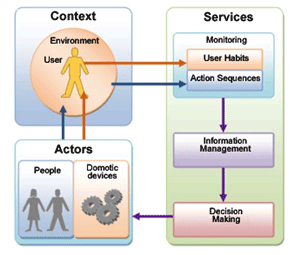by Vittorio Miori, Dario Russo and Alessandro Pulidori
With the increasing influence of technology on our lives, it is becoming ever more important to offer new ambient intelligence solutions which enable humans to adapt and organize their lives around computational technologies and technologies that adapt to meet user behaviour. We apply machine learning techniques to demonstrate how user needs can be satisfied and anticipated by adding Ambient Intelligence solutions to any environment equipped with well-established commercial domotic systems.
Ambient Intelligence (AmI) denotes the presence of a digital environment that is sensitive, adaptive and responsive to the presence of people. We have applied a data mining approach of association rule learning and statistical algorithms in the development of a system prototype that learns from the experience and habits of people in their domestic environments. As shown in Figure 1, the first step in the life cycle of our AmI-based system is the acquisition of information about the users and their environment by means of a monitoring service software module. The data is then analysed and processed by the information manager module. A decision making software application uses this processed information to identify the actions to be performed. Decisions are translated into commands and are sent to the recipient actors (ie people or devices).

Figure: Ambient Intelligence solutions are sensitive, adaptive and responsive to the presence of people.
These concepts are applied within a home environment equipped with domotics, ie, modern technologies that are used to control and manage all our domestic installations. Our approach uses the DomoNet framework developed by our Domotics Laboratory of the Institute of Information Science and Technologies (ISTI) of the National Research Council of Italy (CNR) in Pisa. The solution is a semantic DomoNet component based on the action sequence concept. In our context, an action sequence is a set of undefined number of normal interactions with domotic appliances, where the order of their execution is not relevant.
Our prototype includes two complementary and interoperable machine learning modules:
- Association rules manager: this module applies a data mining paradigm. It learns action sequences that represent user habits, considering all action sequences that occur within a fixed short temporal gap or that are executed with systematic periodicity (ie each day at the same time). These action sequences are learnt using the association rule learning technique with the constraint of the Apriori algorithm to select the relevant rules. In the literature many other machine learning approaches exist to cope with this problem (such as neural networks or some variant of Bayesan classifiers or Markov models) but our choice facilitates the management of a non-ordered action list and requires a lower computational time.
- Statistic rules manager: the second module is designed to learn scenarios related to the domestic preferences of the user, such as temperature and lighting levels for a favorite room, or scenarios related to the identification of anomalies which do not comply with the preference rules. For this purpose, the module creates a user profile obtained using a statistical approach by analysing the frequency and percentage of use of the appliances. This data is obtained by monitoring DomoNet activities according to the preferences learnt from experience. This statistical inference is performed at preset intervals during the entire day.
The entire system learns rules in real time and is able to modify its operational mode when user habits change.
The prototype was developed and tested at the ISTI Domotics Laboratory where the DomoNet framework is running. Three volunteer colleagues with no knowledge about the functionalities of the prototype tested it for a period of one month.
The parameters (confidence, support, window size and correlation threshold percentage use of the device) were obtained empirically by testing and cross-validation on datasets incremented dynamically during the use of the system. The support parameter was decreased each day, and reached zero when the dataset was sufficiently large.
This methodology made it possible to avoid learning uncorrected action sequences during the first phase of the process (when the dataset does not contain sufficient information).Once the dataset has been “warmed-up” (ie is sufficiently large), the learning process can add new habits as new rules by decreasing the support parameters. We found that by setting initial support at 10%, confidence at 90%, the correlation window at 30 seconds and the percentage threshold at 80%, we obtained the best results. In fact, 90% of the action sequences were identified.
At the end of the learning period, the system was able to recognize the habits of two of the three volunteers. The first was accustomed to taking a shower around 7 a.m. and to watching TV with soft lighting. The system learnt to warm the bathroom at the right time in the morning and to switch on the TV and the light of the living room at the desired intensity while switching off all lights in the other rooms. The second user was accustomed to returning home from work in the evening and first relaxing in the bedroom while listening to music and then taking a shower. The system has learnt to play the user’s favourite music while it warms the bathroom in the evening when the user switches on the bedroom light.
Links:
Domotics Lab Home Page: http://www.isti.cnr.it/research/unit.php?unit=HA§ion=home
DomoNet Home Page: http://sourceforge.net/projects/domonet/
Please contact:
Vittorio Miori, Dario Russo, Alessandro Pulidori
Domotics Lab - ISTI CNR, Italy
E-mail: {vittorio.miori, dario.russo, alessandro.pulidori}@isti.cnr.it










